Chinese art 1368 to the 20th century
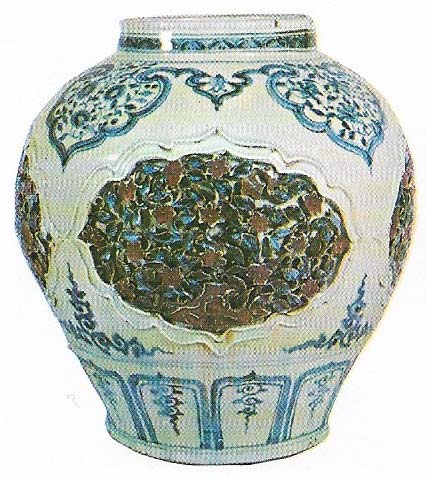
Figure 1. White porcelain was made in a wide range of styles and decorated in Colbert and copper under glaze, as is this large wine jar from the 15th century, which was made at Ching-te-chen, Kiangsi. Cut-through techniques often included an inner decorated vessel.
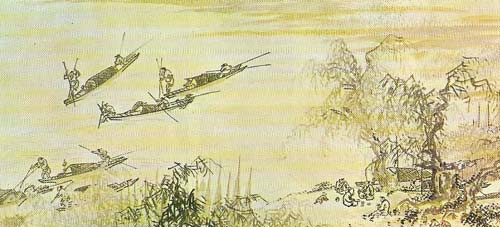
Figure 2. A native of Chekiang, Tai Chin became a court artist for a short time but he was banished to Hangchow where he painted his major works. He is regarded as the leader of the Che School. This handscroll on ink and color on paper called "Fishermen on the river".
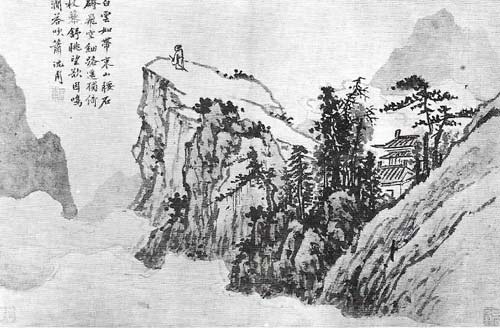
Figure 3. Shen Chou came from a scholarly family. He first followed the painter Huang Kung-wang but later established his own simple style. This album leaf in ink is called "Poet singing in the Mountain".
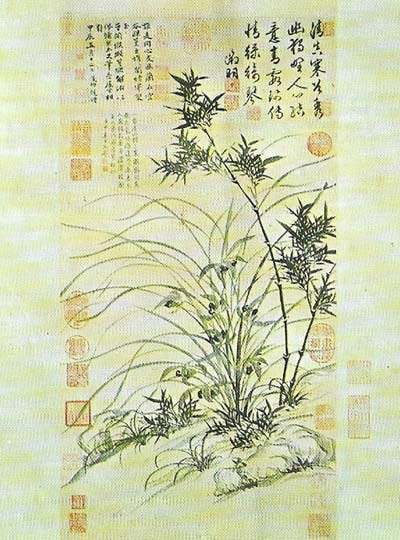
Figure 4. Wen Cheng-ming was the head of a notable family of painters from Tsang Chou. His style was both elegant and decorative and included the popular subject shown here of "Bamboo and Epidendrum".
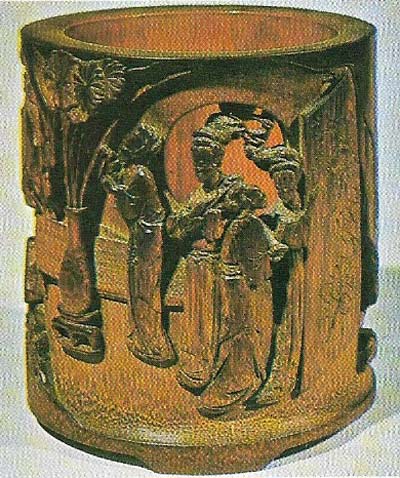
Figure 5. Carved by Chu San-sung, in the 16th century, this bamboo brush pot was designed to hold a scholar's pens and brushes.
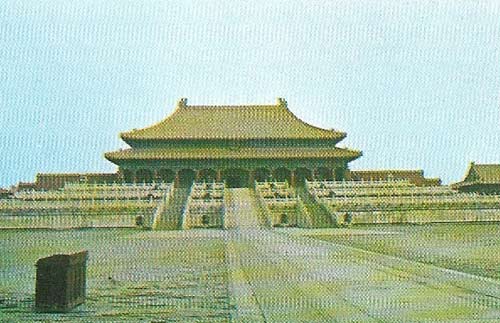
Figure 6. The Forbidden City, palace of the Ming emperors, is enclosed within a large, rectangular, moated, walled compound. The central north-south axis is marked by a series of huge audience halls each flanked by smaller halls and surrounded by large courtyards and tiered walks. The buildings are of gaily painted wood with yellow glazed roofs; the surrounding courts are constructed of white marble.
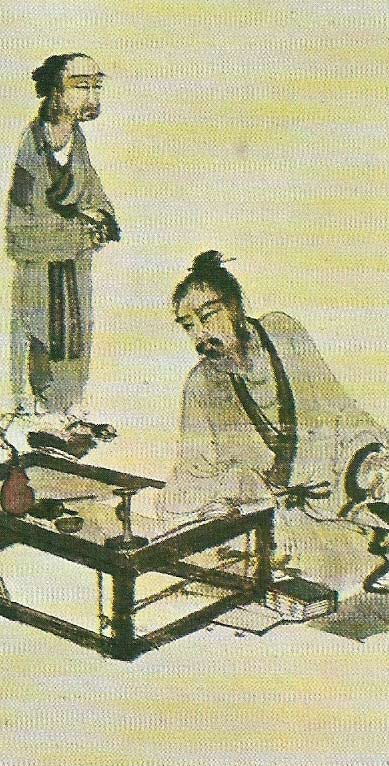
Figure 7. Fu Pao-Shih (1904–1965), one of the major Chinese painters of the 20th century, studied in Japan in the 1930s and was highly influential as a teacher at the Nanking Academy of the Arts. This is his "Scholar in his study".
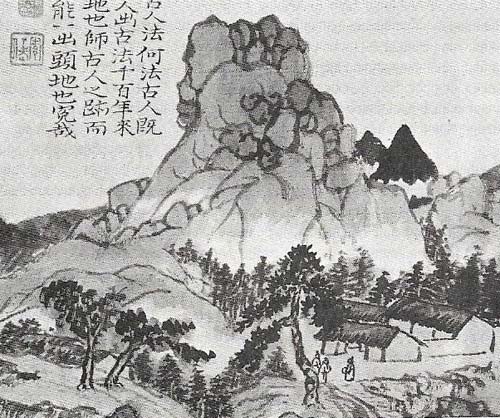
Figure 8. In inventive artist in both techniques and subject-matter, Shih T'ao was a late 17th century recluse who corresponded with his contemporaries and was one of the most influential artists in his own and later generations. His quite distinctive use of the surface texture of the paper, as in this landscape in ink and color, is still being explored today.
With the establishment of the Ming dynasty, Chinese society, as reflected in the arts, underwent a renaissance. The style of the arts of the succeeding three centuries is reminiscent of the Tang dynasty in its boldness and grandeur. The Imperial Palace (Forbidden City) (Figure 6) and the imperial tombs of Peking embody much of this style. The large scale of the buildings and the use of immense space in the layout of courtyards and processional ways show the confidence and flair of the designers.
The arts during the Ming dynasty
The applied arts also flourished, particularly during the earlier centuries of the dynasty. Carved lacquer of beautiful quality was made by masters in small workshops. By contrast the anonymous ceramic industry had grown to considerable production and was by now centralized on the great kiln area of Ching-te-chen, Kiangsi.
Added to the home market the overseas trade in ceramics was rapidly accelerating. The taste for decorated porcelain led to the development of techniques hitherto unexplored. First, the use of underglaze painting in cobalt blue was perfected through various styles (Figure 1); second, by the sixteenth century low-fired colored glazes painted on top of the primary porcelain glaze and refired produced the increasingly popular polychrome decorated wares. Cloisonné enamels on metal bodies also produced rich effects. This technique, of much earlier origin, originally came from the Near East. The grandly simple jade carving is rare and it shows an affinity in style with early Ming lacquer work. In the later years of the dynasty there was a move towards elaboration exemplified by the use of inlay and onlay of semiprecious stones on both jade and porcelain.
The fine arts of the Ming reflect the tastes and position of the scholar classes. At the beginning of the dynasty a variety of styles of painting were practiced. The court attempted to re-establish an academy on traditional lines. Painters such as Tai Chin (1390–1460) (Figure 2) served for a time but soon retired and became the center of a group known as the Che School (centered on Chekiang). Using color and a broad, wet brushwork they produced marvelously evocative genre paintings of country people and elegant landscape and bamboo compositions. Because of their early association with the fashionable court and its intrigues, the members of this school gained a reputation for slight, showy work.
The Wu School and its successors
The great rivals of the Che School were the Wu School, headed by Shen Chou (1427–1509) (Figure 3), a native of Wu Hsi. Painters of this group kept away from court and followed the great masters of Yuan, living as scholar literati and painting in an eclectic scholarly style. Shen Chou himself never took up official life. He was the first painter to use his own poetry as part of his painting and also to use figures in the composition in such a way as to invite the viewer to identify with the figure and so become directly involved with the painting.
Wen Cheng-ming (1470–1559) (Figur 4), Shen Chou's pupil, showed a certain decorative quality in his work, which typified a move that eventually caused concern to the purists. These scholars made an analytical and historical study of painting that was intended to rectify what they saw as a trivialization. Their precepts and classification were a great influence on painters and critics of later periods.
The painters of the generation following the purist Tung Ch'i-ch'ang (1555–1636) were mindful of his analysis and the four Wangs (men with the surname Wang, but not all related) are often regarded as being the followers of Tung. The two elder Wangs, Wang Shin-min (1592–1680) and Wang Chien (1598–1677), follow Wen Cheng-ming and the later Wu School. They painted large eclectic landscape compositions but were also part of the general movement towards a high Romantic style that flowered in the eighteenth century.
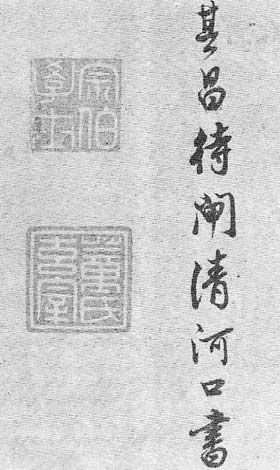 |
| This calligraphy by Tsung Ch'i-ch'ang (1555–1636) is strong and fine and typifies the Chinese scholar-painter's command of his art form. Ting was a theorist and historian who also painted landscapes and lighter works. |
Contemporary with the elder Wangs were Shih T'ao (1641–1720) and Chu Ta (1626–1705). Shih T'ao was by inclination a scholar-painter who relied a great deal on literary inspiration (Figure 8). He was an innovator in the use of ink, color and brush. Chu Ta was an instinctive Ch'an (Zen) artist with an elegant brush style.
At this time a generation of Romantic painters appeared. With the establishment of the grand courts of the Ch'ing, K'ang Hsi, Yung Cheng and Chien Lung, Romantic art was served by the European Jesuit painters led by Castiglione (Lang Shi-ning (1698–1768)), whose curious Italianate-Chinese style was true chinoiserie.
Chinese art to the present day
In the seventeenth century, the newly wealthy towns of Souchow and Yangchow were the homes of an innovative group of painters known as the Eccentrics, who advertised their wares and painted for money. The 18th century saw a strong taste for archaism in all crafts. With the dawn of the 19th century both artist and patron seem to have lost confidence: painting moved slowly and hesitantly along the old paths of the seventeenth century.
 |
| Wu Ch'ang-shih (1842–1927) followed the broader ink style of the late 19th century as well as adopting the current subjects – birds and flowers. |
Twentieth-century Chinese artists were unsure of their direction and they experimented first with European and Japanese styles. Communism redirected the arts to serve political aims, so they had a dominant propaganda function.
